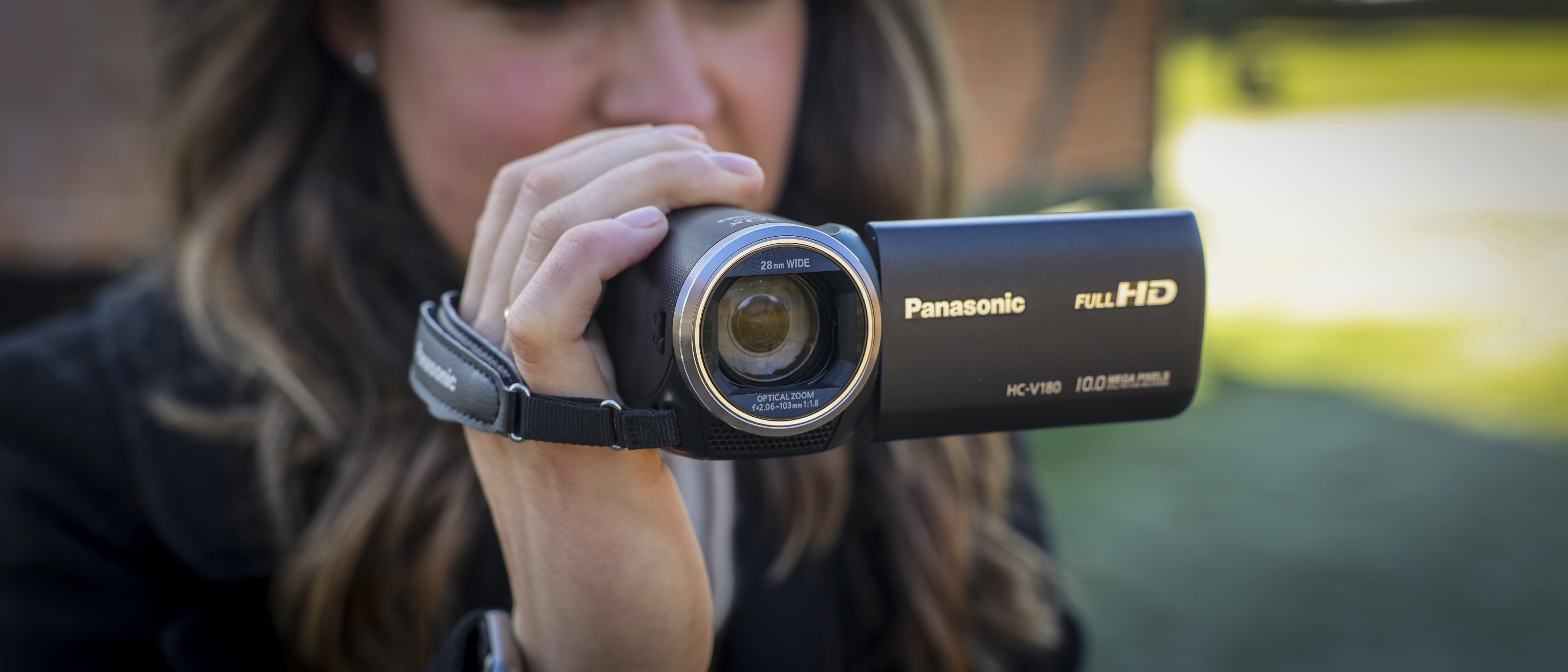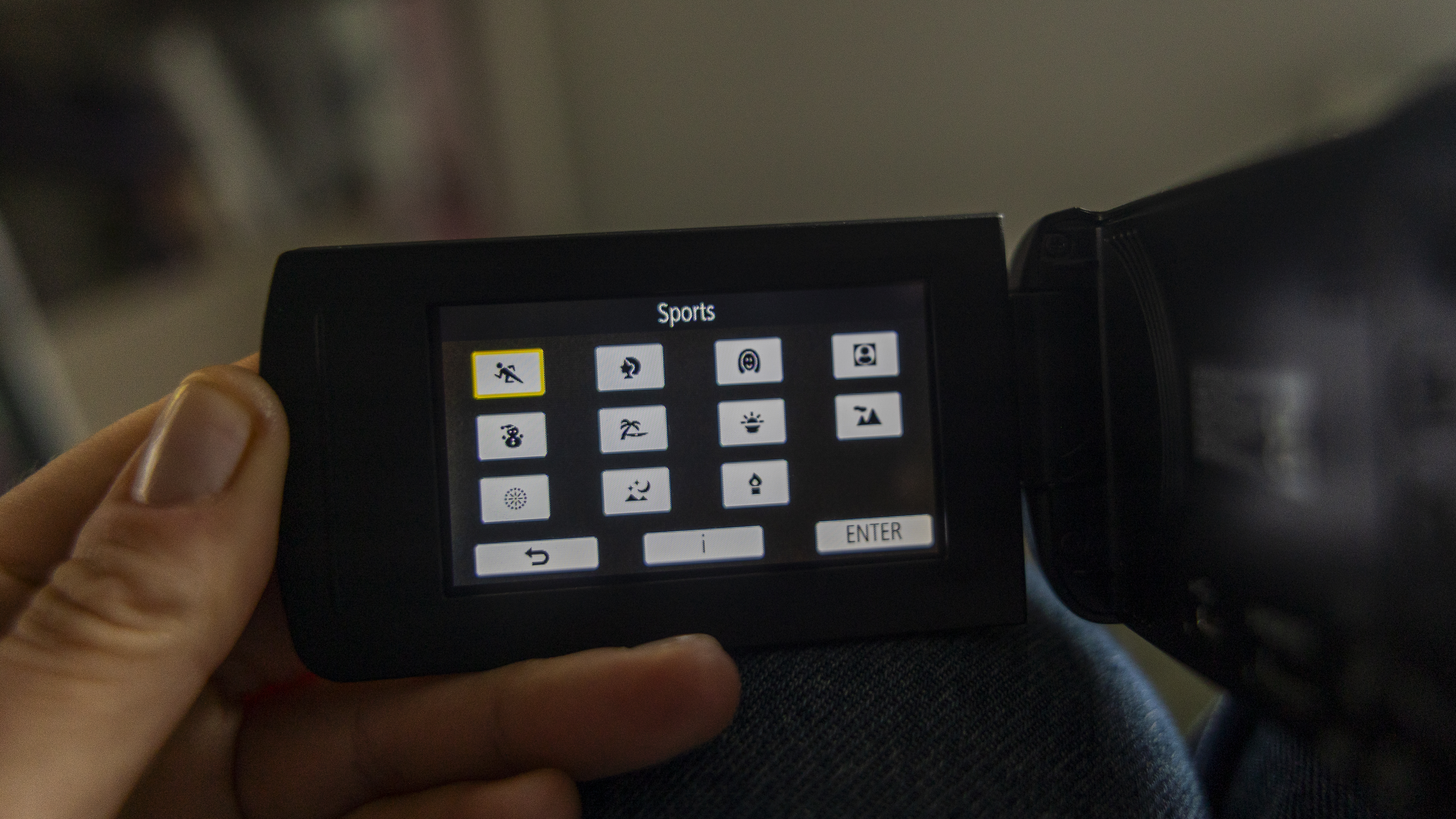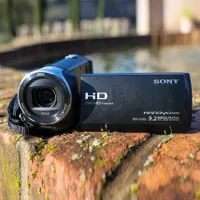Digital Camera World Verdict
The Panasonic HC-V180 is a strong contender for budget-conscious camcorder buyers, but it's showing its age. The setup is quick and the controls are user-friendly, but the video quality is so-so and grainy in lower light. Its standout feature is the impressive 50x optical zoom, which is excellent for wildlife watching and stable even at full power. The HC-V180 is a good choice if you prioritize zoom capabilities and compact sizing above cinematic visuals.
Pros
- +
Wide-angle good for vlogging
- +
Incredibly lightweight
- +
Powerful zoom
Cons
- -
Unresponsive touchscreen
- -
Menus aren't always clear
- -
Slow to turn on
Why you can trust Digital Camera World
The best camcorders are back in fashion, but were they ever out? Video is still the fastest-growing sector for content creation, and camcorders have plenty of USPs. They're great for handheld footage, come with all-in-one lenses, and, if they're anything like the Panasonic HC-V180, offer epic zooming potential far beyond what the best phone for video recording is capable of.
With a 50x optical zoom and a 28mm wide-angle setting for landscape scenic and group shots, the HC-V180 seems like the ultimate travel companion. The best cinema cameras are bulky and expensive, while the budget Panasonic HC-V180 is cheap and compact. It's the company's budget, entry-level camcorder and one of the last remaining from a bygone era, having been released more than eight years ago.
Suitable for beginners, it offers few complex settings and can be used entirely in automatic exposure and focus mode for good results. Its key features include a 1/5.8-type BSI MOS sensor, extended 90x digital zoom, and 5-axis hand-shake detection.
Max resolution: 1920 x 1080
Sensor: 1/5.8-type BSI MOS
Total pixels: 2.2MP
Zoom: 50x optical
Memory type: SD/SDHC/SDXC
Dimensions: 53 x 116 x 59mm (W x D x H)
Weight: 211g (body only)
Unlike advanced camcorders, the HC-V180 doesn't incorporate Wi-Fi or GPS, doesn't let you attach a microphone or use headphones to check audio levels, and certainly doesn't offer 4K recording. You'll get Full HD with a resolution of 1920 x 1080, complimented by a range of filter effects to test your filmmaking prowess.
The HC-V180 is cheap, that's for certain. And usually, you get what you pay for. So is the HC-V180 worth using for home movies in today's market? Is it still a capable camcorder, or a piece of nostalgia best left in the past?
Panasonic HC-V180: What's changed?
The Panasonic HC-V180 debuted at CES in January 2016, coinciding with the launch of the 4K UHD WXF991 and HC-VX981 camcorders, as well as two additional Full-HD camcorders, the W580 and V380. It's a direct competitor to the Sony CX405, with a very similar price, size and shape, and even the same-sized sensor.
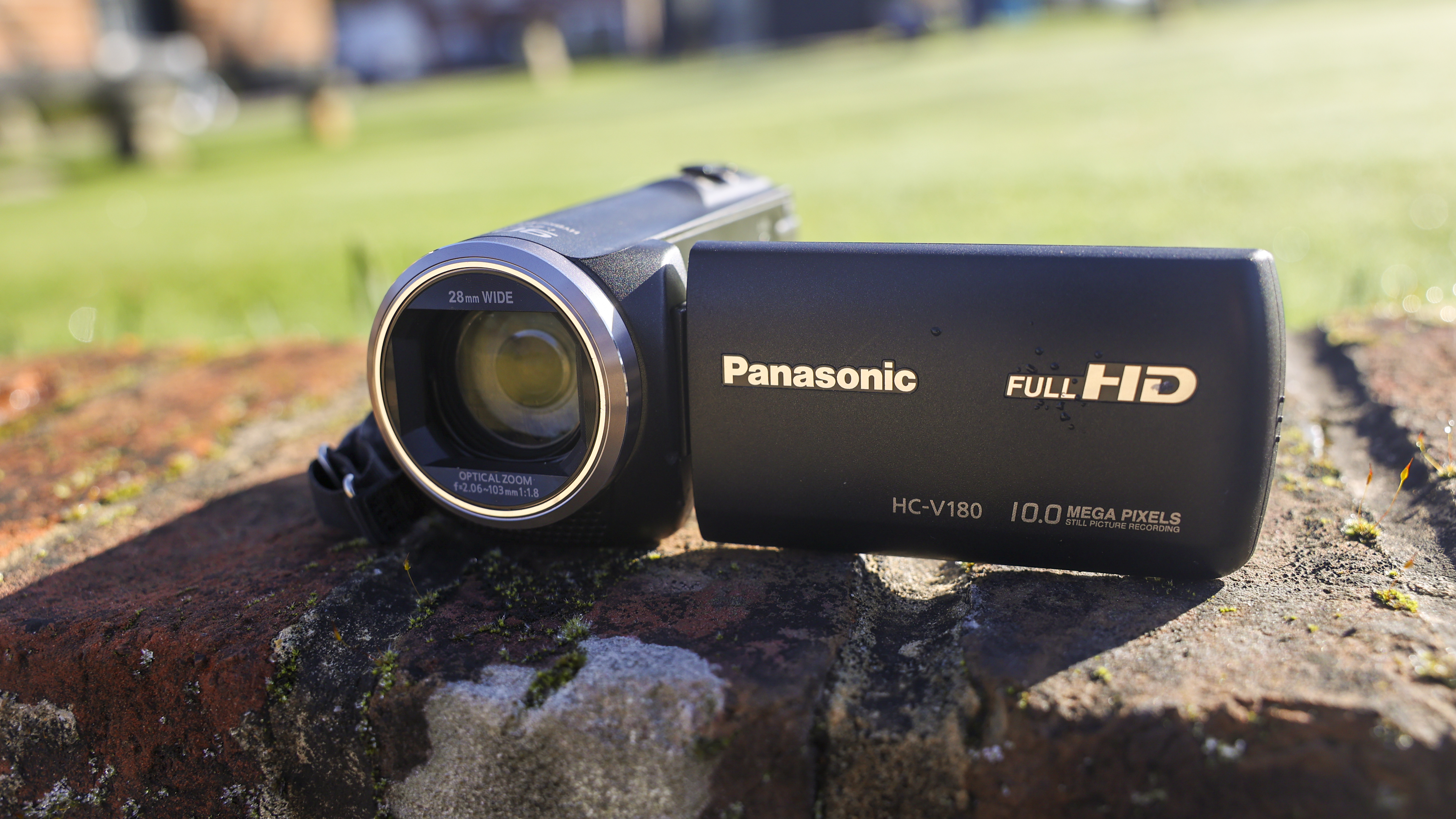
Panasonic HC-V180: Design & Handling
The Panasonic HC-V180 is a diminutive, dinky camcorder. It’s only slightly heavier than my iPhone 15 Pro, but obviously comes in a very different format – a classic barrel-shaped camcorder, shrunk down to a pocket-friendly size. You don’t need a camera bag to carry it around, and I mostly kept it in my jacket pocket during testing spells, which is something that will appeal to traveling vloggers or those who like to travel light.
The best camera deals, reviews, product advice, and unmissable photography news, direct to your inbox!
The overall design is functional, with a black plastic chassis and a few silver accents around the ring, and to highlight features or buttons. The HC-V180 is reminiscent of most camcorders in the early 21st century – it won't win any style competitions and doesn't innovate in any way. But it's comfortable to hold and generally easy to get to everything you need. Overall, I felt that the build quality was rattly, and the lack of weather sealing made me worry about using it in anything but fair weather. For the price point, this level of ruggedness was expected.
Like the rival Sony HDR-CX405, the HC-V180 has very few physical controls – certainly nowhere near the amount you get on an enthusiast-level camcorder like the Canon HF-G70. To the right of the lens, there’s a mechanical switch to open and close the lens shutters. Up on top is a textured, rectangular zoom toggle that also serves as a menu zoom in playback mode. And behind that is a raised button with a camera icon for taking still images, which is easy to find without looking.
The DC-in charging port on the right-hand side of the barrel is hidden behind a slightly flimsy sliding plastic door. The chunky battery sots onto the back of the body, and underneath, another door flips up for access to the SD/SDHC/SDXC slot. A standard tripod thread is underneath, too.
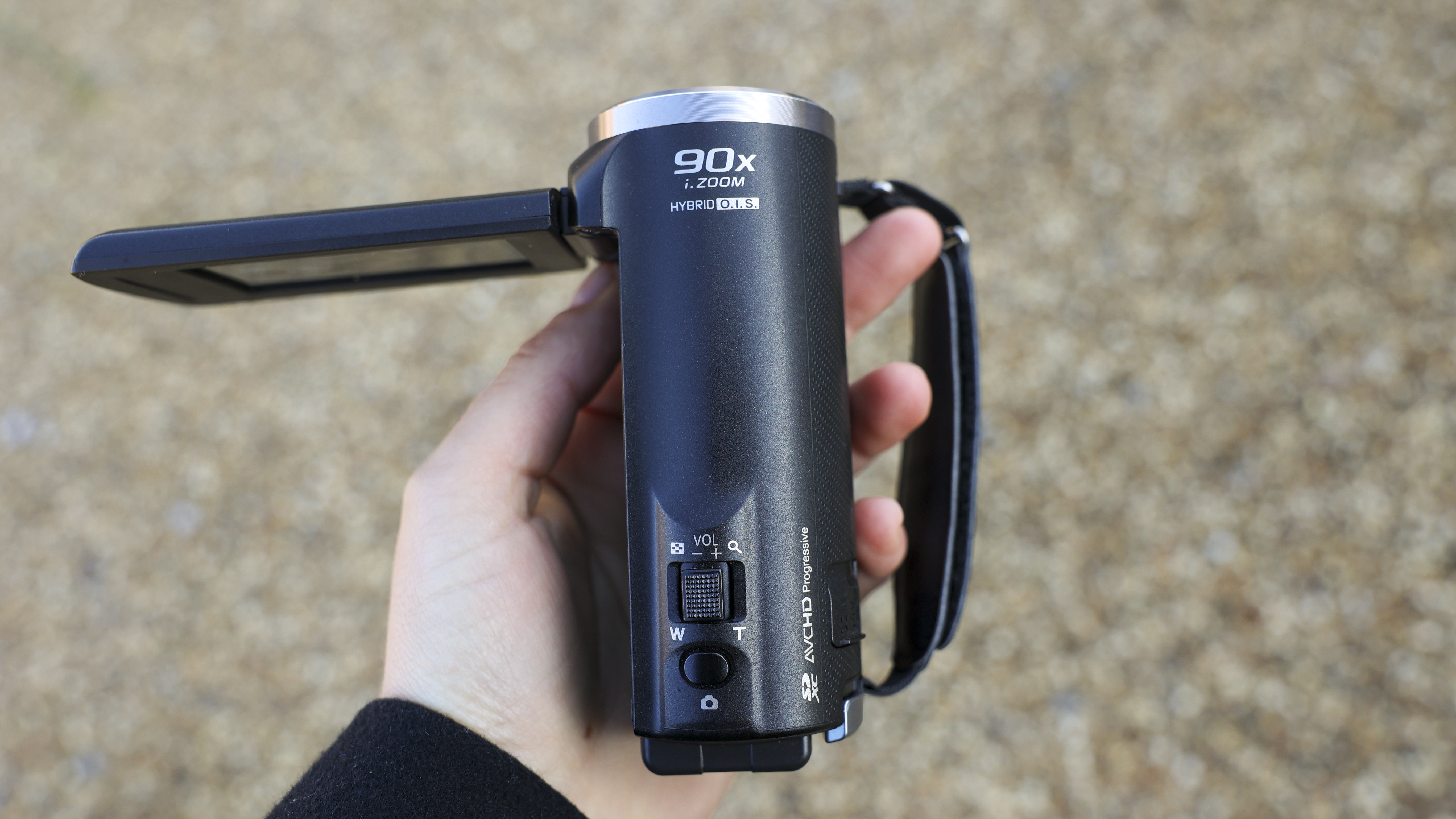
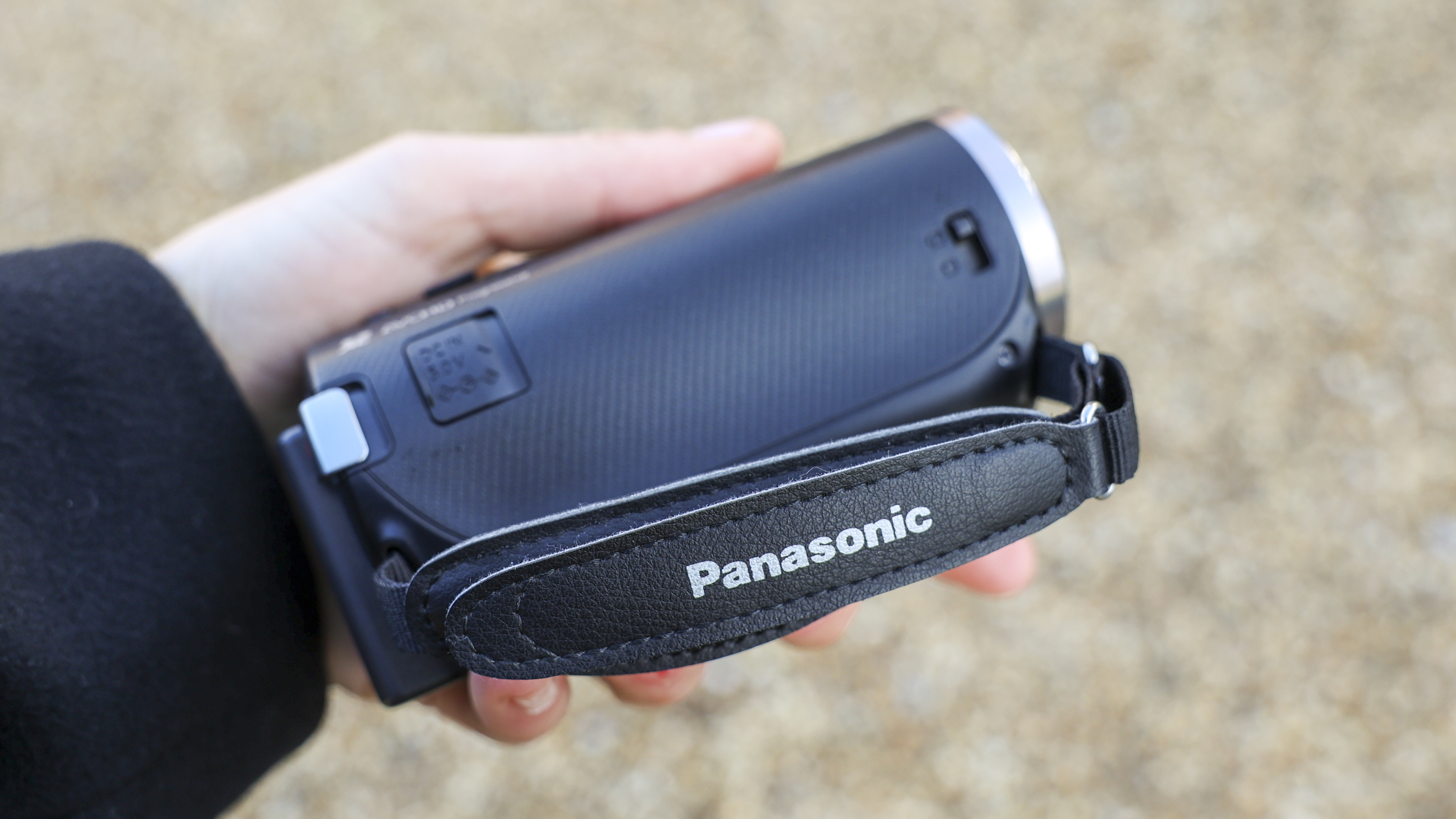
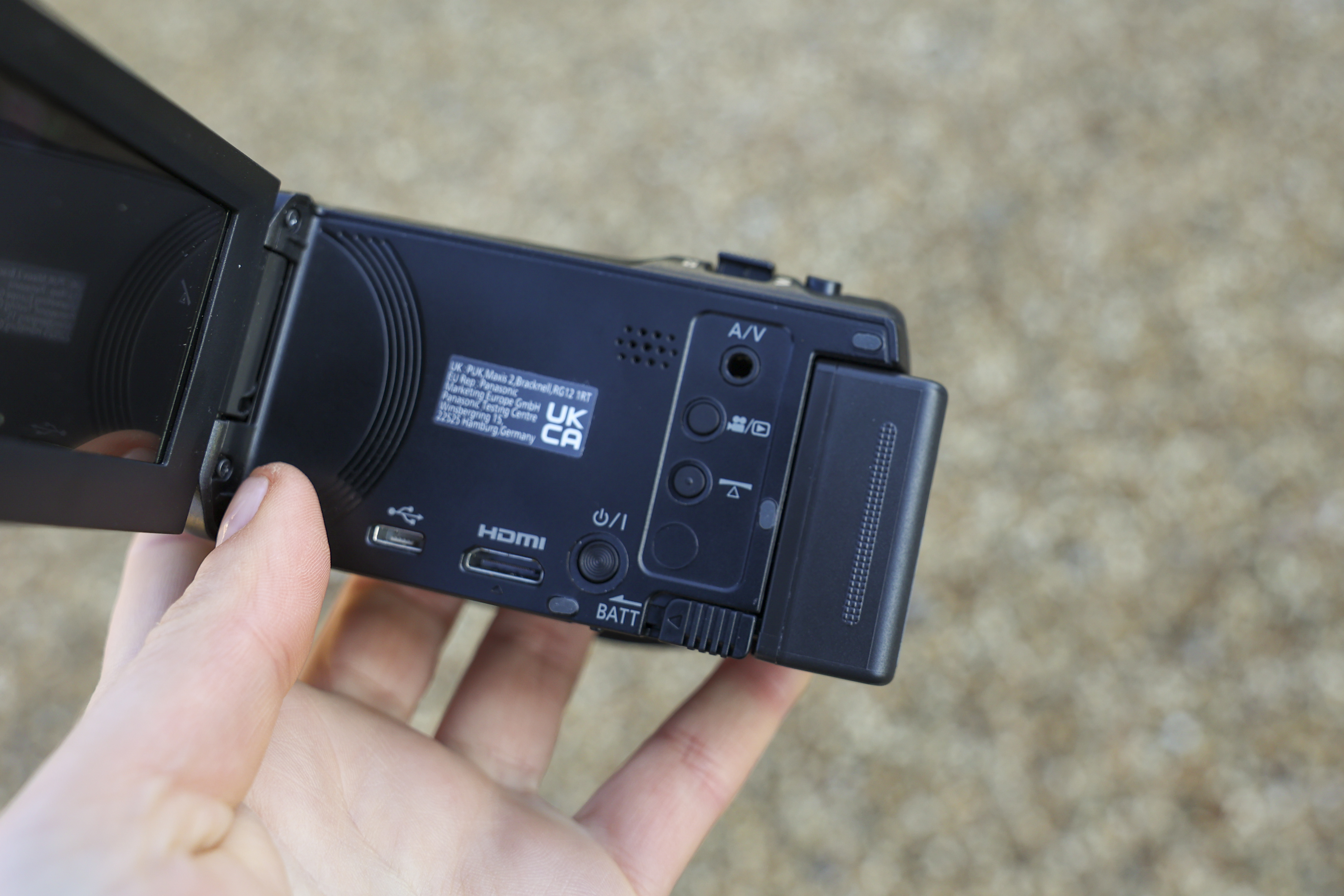
Being a camcorder, handling of the HC-V180 is designed to be mostly one-handed, leaving your left hand free to change settings and angle the screen. I found it comfortable to reach the zoom with an index finger and record button with a thumb when holding the camera. When I asked my partner to test it, his large hands did dwarf the body, but it only takes seconds to adjust the velcro strap if you need to accommodate more room.
Pulling out the HC-V180's 2.7-inch LCD reveals an on/off button, playback button, and level button, plus a mini-HDMI port and micro-USB port – both connections that now feel outdated in the almost-universal world of USB-C. It feels like Panasonic could have given us a bigger screen and smaller black surround to make the most of the camcorder's size. But doing so would likely have increased the cost. You also don't get a microphone or headphone socket, which means you're reliant on the camera's in-built microphone, and can't check audio levels apart from the built-in speakers.
Anyway, there's at least touchscreen operation to change settings and navigate menus, rather than the four-way physical control pad on the Sony HDR-CX450. In theory, this should let you whizz through settings, but the touchscreen is nowhere near as responsive as I've become used to on modern phones and cameras. And in an almost embarrassing show of my millennial age, I didn’t even realize that it was a touchscreen at first because you have to press down so firmly on the screen. Still, once you’re aware of how it works, the operation is mostly smooth.
Panasonic HC-V180: Performance
The Panasonic VC-180’s 50x optical zoom is the main selling point of this camcorder, which is even more impressive when you consider that my flagship iPhone 15 Pro is only capable of a 6x optical zoom range. It also performs beyond many newer camcorders ten times its price, and I was amazed at how well it focused on birds in my back garden, or the moon on a clear night. Stretching beyond 30x optical zoom made me pause, and I was more likely to rely on a tripod to keep the footage stable.
I found the 90x intelligent zoom function (a combo of digital zoom, sharpening, and image up-scaling) unusable unless the camcorder was completely still. Even then, it degraded the image further than I was happy with. On the plus side, the 5-Axis HYBRID O.I.S.+ suppresses blur when you’re not on a stable platform. It does enough to keep handheld walking shots stable and works particularly well when you’re talking to the camera.
In terms of video quality, the HC-V180 is fair but not amazing, which I found acceptable considering its price point and age. Recording at 1080p and 59.94 fps delivers clear footage most of the time, while finer details are captured in abundant lighting but not at night, where noise handling causes muddy renditions and duller tones. AVCHD format is the highest video quality on offer, but the option of MP4 or iFrame formats offer faster sharing and simpler editing.
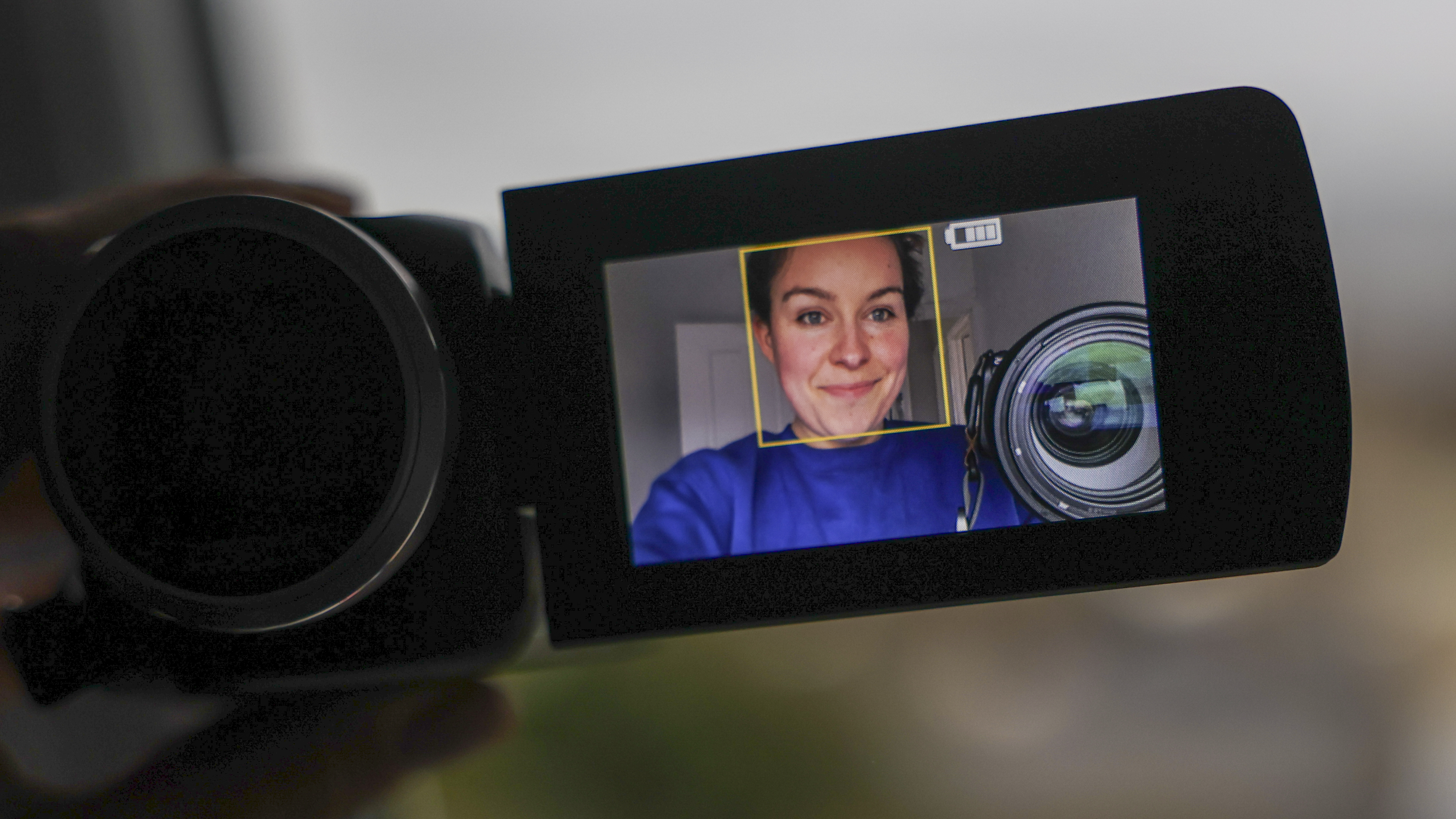
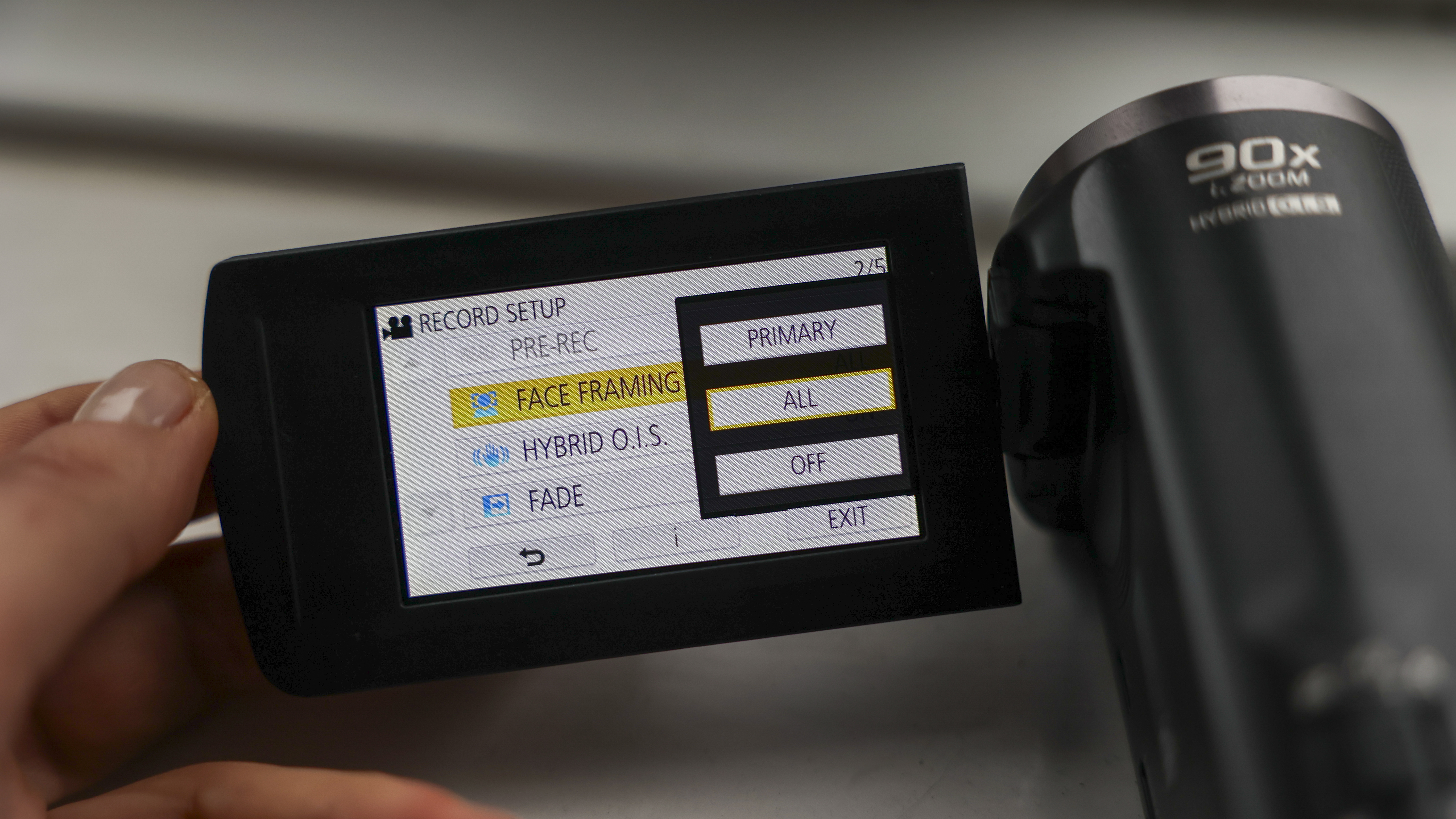
I think most beginners are likely to stick the camcorder in auto and forget about it – an approach that I found worked well. I enjoyed using the camera in manual mode and changing the focus, white balance, shutter and iris (the aperture). It adds versatility and opens the usage up to more advanced shooters who want a long zoom but without the weight or cost.
Of course, the HC-V180 is mainly for entry-level users, and as such it offers a range of shooting modes and creative effects. I was impressed with the time-lapse functionality, but the video effects like the silent movie felt dated and a bit of a gimmick. Scene modes include sports, portraits and soft skin, which I tried across a football match and wedding. Honestly, I couldn't tell the difference between them, and think you'd be better off relying on automatic mode for the most part.
Because the VC-180 doesn’t have an external microphone port, you’re reliant on the built-in zoom stereo microphone. This two-channel mic picks up ambient noise like traffic if you’re filming outside. There's also no option for wind reduction, and I was disappointed with the audio quality through the camcorder’s weak speakers. Once the files were downloaded to my desktop, however, the audio quality was warmer and audible, but still not as crisp as the Sony HDR-CX405.
Another area where it does beat the HDR-CX405 is battery life, which is bigger off the bat but can also be upgraded from the supplied 1940mAh to double the capacity. I got over an hour of recording time out of one battery, but I'd suggest investing in spares if you're going to be out all day or at a long family event.
Panasonic HC-V180: Sample video
Above: sample videos shot with the Panasonic HC-V180
I had the Panasonic HC-V180 sample for just over two weeks, and recorded test footage during the early morning, daytime, and in low light, as well as varying weather conditions. The footage here was mainly captured at 1080p 50fps, and I turned the stabilization on and off, as well as experimenting with and without the digital zoom function. Face detection was also enabled while recording pieces to the camera.
Panasonic HC-V180: Final Verdict
Like the rival Sony HDR-CX405, the Panasonic HC-V180 is ideal for families or travellers who want one of the best camcorders on a budget. It's quick to set up and use straight out of the box, and although the menu systems aren't as intuitive as their modern counterparts, the controls are pleasingly basic.
If you leave this compact camcorder in automatic exposure and focus mode, you can expect image quality that's adequate in well-lit conditions but grainy in low light. You don't notice the lack of clarity when you view recordings back on a laptop screen but plug the camcorder into an HDTV, and things get quite muddy.
The HC-V180 offers fantastic zoom capabilities, however, and this is its main selling point. The huge 50x zoom is 20x further than the Sony HDR-CX405 and can bring faraway objects into impressively close view. I found it ideal for wildlife watching and identification, with the 5-axis image stabilization going a long way to keeping the frame stable.
If you've got little to spend and don't expect the highest-quality video or audio, the HC-V180 is an excellent camcorder to take on your travels. It's got several drawbacks which are down to its age and price bracket - no Wi-Fi, a small sensor, and a cheap build - but it still managed to impress me, and conjure a sense of nostalgia.

Should you buy the Panasonic HC-V180?
✅ Buy this if...
- You're a total beginner
- Your budget is under $250
- You need a pocket-sized product
🚫 Don't buy this if...
- You need low-light performance
- You want audio ports
- You want RAW video formats
Alternatives
The Sony HDR-CX405 is ever so slightly cheaper and lighter than the HC-V180, but it sports the same-sized sensor. With a less powerful 30x optical zoom, it's a decent choice if you don't need a long-range lens, and has a built-in USB charging cable for convenience.
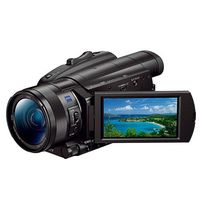
If you need a more advanced camcorder for vlogging, the Sony FDR-AX700 offers both 4K and HD recording, with slow motion at 120 fps. It's about five times the price of the HC-V180, and the optical zoom is much lower at 12x, but the 1-inch sensor gives excellent video quality.

Lauren is a writer, reviewer, and photographer with ten years of experience in the camera industry. She's the former Managing Editor of Digital Camera World, and previously served as Editor of Digital Photographer magazine, Technique editor for PhotoPlus: The Canon Magazine, and Deputy Editor of our sister publication, Digital Camera Magazine. An experienced journalist and freelance photographer, Lauren also has bylines at Tech Radar, Space.com, Canon Europe, PCGamesN, T3, Stuff, and British Airways' in-flight magazine. When she's not testing gear for DCW, she's probably in the kitchen testing yet another new curry recipe or walking in the Cotswolds with her Flat-coated Retriever.
